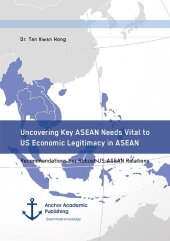 Neuerscheinungen 2016Stand: 2020-02-01 |
Schnellsuche
ISBN/Stichwort/Autor
|
Herderstraße 10
10625 Berlin
Tel.: 030 315 714 16
Fax 030 315 714 14
info@buchspektrum.de |

Tan Kwan Hong
Uncovering Key ASEAN Needs Vital to US Economic Legitimacy in ASEAN. Recommendations For Robust US-ASEAN Relations
2016. 40 S. 14 Abb. 220 mm
Verlag/Jahr: ANCHOR ACADEMIC PUBLISHING 2016
ISBN: 3-9606706-4-8 (3960670648)
Neue ISBN: 978-3-9606706-4-3 (9783960670643)
Preis und Lieferzeit: Bitte klicken
This paper proposes the I-4 Initiative, a set of broad-based recommendations designed to help the US tackle ASEANīs key obstacles to economic growth, and thereby differentiating itself from other competing multilateral economic frameworks, striving to garner ASEANīs involvement. As part of the current situational analysis, this paper also touches on ASEANīs growing economic potential as well as on the viability of the Trans-Pacific Agreement (TPP) and the US-ASEAN Extended Economic Engagement (E3). A posture on how the US can balance both arrangements is also recommended.
Text Sample:
Chapter 2: Crouching Tiger, Hidden Dragon [...]: The Untapped Potential of ASEAN as a Global Economic Force:
Long hidden behind the shadows of India and China, ASEANīs growing strategic relevance in the global economic arena can no longer be dismissed. The region boasts a combined GDP of $1.9 trillion, exceeding that of India; a population of 600 million people, which amounts to almost twice that of the US; and an average per-capita income mirroring Chinaīs.
The region will rank as the fifth largest in Purchasing Power Parity (PPP) terms (Exhibit 1), and is one of the fastest growing developing economic regions globally, with growth rates far outstripping that of the Middle East and Latin America (Exhibit 2). And if India is touted to be a global economic giant, ASEANīs GDP growth rate has already outperformed Indiaīs (Exhibit 3).
ASEAN would also be the region most dependent on trade, with a trade-to-GDP ratio exceeding 150 percent, outperforming that of many other regions. And despite the Asian Financial Crisis, middle-income countries like Indonesia, Malaysia, the Philippines, and Thailand have averaged a remarkable 7 percent annual growth rate since 2000. Also notwithstanding the 2008 global financial crisis, the entire sub-region bounced back brilliantly to soar beyond the 8 percent growth rate mark. This therefore highlighted a region that is resilient to global economic shocks, with the ability to adapt wisely through rapid policy adjustments.
Another avenue that might have piqued US interest on ASEAN lies in the regionīs strategic geographic location (Exhibit 4). The Malacca Straits is the worldīs second busiest shipping channel after the English Channel, and the second most popular oil tanker route, after the Straits of Hormuz. The Melacca Straits is the passage to more than half of the worldīs merchant fleet capacity annually, and disruptions in the straits would be catastrophic to global trade and US regional interest.
And with the materialization of the ASEAN Economic Community (AEC) in 2015, ASEAN will become one of the most integrated economic regions in the world.
The AEC constitutes an initiative to achieve the economic goals set under the umbrella of the ASEAN Community Blueprint (Exhibit 5). It aims to establish ASEAN as a single market and production base, a region fully integrated into the global economy that also achieves equitable economic development between member states, thereby turning it into a highly competitive economic region.
And apart from the economic benefits derived from engagements with a fast rising economic region, the E3 Initiative and other forms of ASEAN public or private sector engagements such as the US-ASEAN Business Forum and the US-funded Maximizing Agricultural Revenue through Knowledge, Enterprise Development, and Trade (MARKET) Program constitutes a hedging strategy towards the slow and arduous progress of the TPP.


